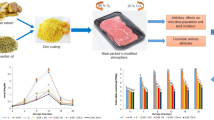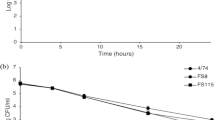Abstract
Controlling foodborne pathogen in ready-to-eat food is important in food safety. The present study accessed the potential use of Rhodomyrtus tomentosa ethanolic leaf extract as a bio-control agent against Listeria monocytogenes in cooked chicken meat model system. The antilisterial activity of the plant extract was better under microwave condition and enhanced as storage temperature increased from 4 to 37 °C. The extract could reduce L. monocytogenes numbers at low (104 CFU/g) and high (106 CFU/g) inoculum levels in cooked chicken by both rinse and injection application methods. A 5 min rinse in 8% w/v R. tomentosa extract reduced the bacterial number by ≥2-log before storage and ≥3-log after storage at 4 °C for 5 days. Injection with 0.4% w/w R. tomentosa extract resulted in approximately 2-log reduction in the cell numbers both before and after storage at 4 °C for 5 days. Five minutes rinse in the extract bath demonstrated better sensory preferences which were not significantly different from the control. Addition of black pepper powder to the extract rinsed samples improved odour but not appearance, colour, and texture preferences. Rhodomyrtus tomentosa extract was significantly effective for the bio-control of L. monocytogenes contaminations in cooked chicken meat model. The extract was observed as a potent bio-additive agent to control contaminations from L. monocytogenes and ensure safety in ready-to-eat meat.




Similar content being viewed by others
References
Babuskin S, Babu PAS, Sasikala M, Sabina K, Archana G, Sivarajan M, Sukumar M (2014) Antimicrobial and antioxidant effects of spice extracts on the shelf life extension of raw chicken meat. Int J Food Microbiol 171:32–40
Doyle M (2015) Investigation of a multi-state listeriosis outbreak associated with caramel apples. Paper presented at the 2015 CSTE annual conference
Du WX, Avena-Bustillos RJ, Woods R, Breksa AP, McHugh TH, Friedman M, Levin CE, Mandrell R (2012) Sensory evaluation of baked chicken wrapped with antimicrobial apple and tomato edible films formulated with cinnamaldehyde and carvacrol. J Agric Food Chem 60:7799–7804
El Abed N, Kaabi B, Smaali MI, Chabbouh M, Habibi K, Mejri M, Marzouki MN, Ben Hadj Ahmed S (2014) Chemical composition, antioxidant and antimicrobial activities of Thymus capitata essential oil with its preservative effect against Listeria monocytogenes inoculated in minced beef meat. Evid Based Complement Altern Med 2014:152487. doi:10.1155/2014/152487
European Food Safety Authority (EFSA) and European Centre for Disease Prevention and Control (ECDC) (2015) The European Union summary report on trends and sources of zoonoses, zoonotic agents and food-borne outbreaks in 2013. EFSA J 13(1):3991
Higginbotham KL, Burris KP, Zivanovic S, Davidson PM, Stewart CN (2014) Aqueous extracts of Hibiscus sabdariffa calyces as an antimicrobial rinse on hot dogs against Listeria monocytogenes and methicillin-resistant Staphylococcus aureus. Food Control 40:274–277
Knabel S (2015) Tracking and controlling Listeria monocytogenes in food processing plants. Paper presented at the 2015 SIMB annual meeting and exhibition
Lavanya G, Voravuthikunchai SP, Towatana NH (2012) Acetone extract from Rhodomyrtus tomentosa: a potent natural antioxidant. Evid Based Complement Altern Med 2012:535479. doi:10.1155/2012/535479
Lazaridou A, Duta D, Papageorgiou M, Belc N, Biliaderis C (2007) Effects of hydrocolloids on dough rheology and bread quality parameters in gluten-free formulations. J Food Eng 79:1033–1047
Limsuwan S, Subhadhirasakul S, Voravuthikunchai SP (2009a) Medicinal plants with significant activity against important pathogenic bacteria. Pharm Biol 47:683–689
Limsuwan S, Trip EN, Kouwen TR, Piersma S, Hiranrat A, Mahabusarakam W, Voravuthikunchai SP, van Dijl JM, Kayser O (2009b) Rhodomyrtone: a new candidate as natural antibacterial drug from Rhodomyrtus tomentosa. Phytomedicine 16:645–651
Masuku S, Babu D, Martin E, O’Bryan C, Crandall P, Ricke S (2014) Lethality of moist heat and silver dihydrogen citrate sanitizer combinations on Listeria spp. adhered to components of a deli meat slicer. Food Control 44:227–232
Miceli A, Aleo A, Corona O, Sardina MT, Mammina C, Settanni L (2014) Antibacterial activity of Borago officinalis and Brassica juncea aqueous extracts evaluated in vitro and in situ using different food model systems. Food Control 40:157–164
Mitsumoto M, O’Grady MN, Kerry JP, Buckley DJ (2005) Addition of tea catechins and vitamin C on sensory evaluation, colour and lipid stability during chilled storage in cooked or raw beef and chicken patties. Meat Sci 69:773–779
Muthukumar M, Naveena B, Vaithiyanathan S, Sen A, Sureshkumar K (2014) Effect of incorporation of Moringa oleifera leaves extract on quality of ground pork patties. J Food Sci Technol 51:3172–3180
Odedina GF, Vongkamjan K, Voravuthikunchai SP (2015) Potential bio-control agent from Rhodomyrtus tomentosa against Listeria monocytogenes. Nutrients 7:7451–7468
Saising J, Ongsakul M, Voravuthikunchai SP (2011) Rhodomyrtus tomentosa (Aiton) Hassk. ethanol extract and rhodomyrtone: a potential strategy for the treatment of biofilm-forming staphylococci. J Med Microbiol 60:1793–1800
Solomakos N, Govaris A, Koidis P, Botsoglou N (2008) The antimicrobial effect of thyme essential oil, nisin, and their combination against Listeria monocytogenes in minced beef during refrigerated storage. Food Microbiol 25:120–127
Srey S, Park SY, Jahid IK, Ha S-D (2014) ). Reduction effect of the selected chemical and physical treatments to reduce L. monocytogenes biofilms formed on lettuce and cabbage. Food Res Int 62:484–491
Sun-Waterhouse D, Wadhwa SS (2013) Industry-relevant approaches for minimising the bitterness of bioactive compounds in functional foods: a review. Food Bioprocess Technol 6:607–627
Temilade IBO (2009) Effect of Eleutherine americana Merr. Bulb extracts on food poisoning Staphylococcus aureus and its application in food systems. Prince of Songkla University
Veldhuizen EJ, Creutzberg TO, Burt SA, Haagsman HP (2007) Low temperature and binding to food components inhibit the antibacterial activity of carvacrol against Listeria monocytogenes in steak tartare. J Food Prot 70:2127–2132
Voravuthikunchai SP, Dolah S, Charernjiratrakul W (2010) Control of Bacillus cereus in foods by Rhodomyrtus tomentosa (Ait.) hassk. leaf extract and its purified compound. J Food Prot 73:1907–1912
World Health Organisation (WHO) (2015) Basic information on emerging infectious diseases (EIDs): listeriosis: what we should know. Disease Surveillance and Epidemiology Unit, World Health Organization Regional Office for South-East Asia (WHO SEARO), pp 1–4. Accessed 15 Sept 2015
Xi Y, Sullivan G, Jackson A, Zhou G, Sebranek J (2011) Use of natural antimicrobials to improve the control of Listeria monocytogenes in a cured cooked meat model system. Meat Sci 88:503–511
Yusop SM, O’Sullivan MG, Kerry JF, Kerry JP (2012) Influence of processing method and holding time on the physical and sensory qualities of cooked marinated chicken breast fillets. LWT Food Sci Technol 46:363–370
Zhu L, Chirase N, Ravishankar S (2014) Use of fulvic acid or sodium silicate-based sanitizers to inactivate Listeria monocytogenes, Salmonella Typhimurium and Pseudomonas aeruginosa on food contact surfaces. J Food Saf 34:132–140
Acknowledgements
This work was supported by TRF Senior Research Scholar (Grant No. RTA5880005), the Thailand Research Fund and Natural Product Research Center of Excellence, Prince of Songkla University.
Author contributions
All the authors designed the study and interpreted the results. GFO completed the experimental work and drafted the manuscript. SPV and KV supervised and provided expertise throughout the process. All the authors reviewed and contributed to the scientific contents of the paper.
Author information
Authors and Affiliations
Corresponding author
Ethics declarations
Conflict of interest
The authors declare no conflict of interest with any organization regarding the materials and details discussed in the manuscript.
Rights and permissions
About this article
Cite this article
Odedina, G.F., Vongkamjan, K. & Voravuthikunchai, S.P. Use of Rhodomyrtus tomentosa ethanolic leaf extract for the bio-control of Listeria monocytogenes post-cooking contamination in cooked chicken meat. J Food Sci Technol 53, 4234–4243 (2016). https://doi.org/10.1007/s13197-016-2417-3
Revised:
Accepted:
Published:
Issue Date:
DOI: https://doi.org/10.1007/s13197-016-2417-3




